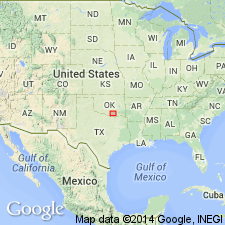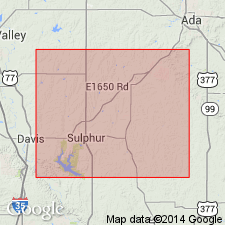
- Usage in publication:
-
- Clarita member
- Modifications:
-
- Original reference
- AAPG geologic province:
-
- Arkoma basin
- South Oklahoma folded belt
Summary:
Pg. 6 (fig. 3), 19-25, fig. 4; 1960, Oklahoma Geol. Survey Bull., no. 84, pt. 6, p. 52-67. Clarita member of Chimneyhill limestone. Name proposed to replace Maxwell's (1936) preoccupied name Dillard. Fossiliferous limestone ranging from fine calcilutite to coarse calcarenite. Most common facies is calcilutite. Thickness varies; commonly less than 20 feet; maximum thickness 45 feet (on Lawrence uplift). Unconformably overlies Cochrane; base of Clarita marked by a few inches of shale or shaly limestone. Unconformably underlies Hunton marlstone; at some places it is the Henryhouse and at other places the Haragan that overlies the Clarita. Age is Middle(?) Silurian.
Type locality: about 3 mi west of Clarita, Coal Co., in vicinity of old Hunton townsite, in NW/4 sec. 8, T. 1 S., R. 8 E. This is not the same as type locality designated for the Dillard
Source: US geologic names lexicon (USGS Bull. 1200, p. 821).

- Usage in publication:
-
- Clarita Formation
- Modifications:
-
- Revised
- AAPG geologic province:
-
- Arkoma basin
- South Oklahoma folded belt
Summary:
Clarita Formation of Chimneyhill subgroup [informal] of Hunton Group. Described from the Arbuckle Mountains, south-central Oklahoma. Includes newly named members (ascending): Prices Falls Member, a thin shale or marl (upper Llandoverian), and Fitzhugh Member, a biomicrite and biosparite (lower Wenlockian). Unconformably overlies Cochrane Formation of Chimneyhill and unconformably underlies Henryhouse Formation. Fossils (forams, conodonts, crinoids, ostracods, brachiopods). Age is Early and Middle Silurian (late Llandoverian and early Wenlockian). Report includes stratigraphic chart.
["Subgroup" not recognized as a formal stratigraphic rank term (CSN, 1933; ACSN, 1961, 1970; NACSN, 1983, 2005, 2021). Considered informal and should not be capitalized.]
Source: Modified from GNU records (USGS DDS-6; Denver GNULEX).
For more information, please contact Nancy Stamm, Geologic Names Committee Secretary.
Asterisk (*) indicates published by U.S. Geological Survey authors.
"No current usage" (†) implies that a name has been abandoned or has fallen into disuse. Former usage and, if known, replacement name given in parentheses ( ).
Slash (/) indicates name conflicts with nomenclatural guidelines (CSN, 1933; ACSN, 1961, 1970; NACSN, 1983, 2005, 2021). May be explained within brackets ([ ]).

